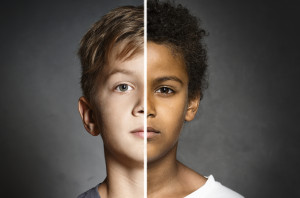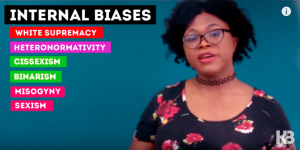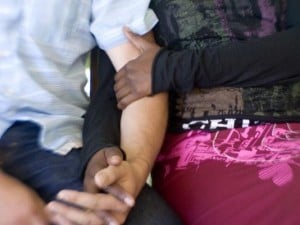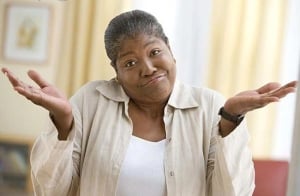
A person serving a turkey on a dining room table covered in festive foods and decorations.
“Thanksgiving” is a weird time when we get stuck with conservative family members who might trigger us so much that it feels almost impossible to formulate a sentence.
Especially this year – when the entire election cycle seemed dominated by not just sexism, but sexual assault and not just “colorblind” racism, but racial terror – we may find ourselves at a loss for how to make an appeal to our conservative uncles, cousins, and parents.
Trust me when I say I know how hard that can be.
I’m definitely not saying to cross boundaries of physical or emotional safety. I am, however, hoping white allies can show up really hard right now because, well, we need you. We need you to be uncomfortable so that queer folks, undocumented people, Muslims, survivors, and countless others can feel safe.
So particularly, if you are one of the few of the cohort of white progressives/radicals/do gooders, we need you to go ahead and call-in Randy, Travis, and Becky. I’ll even give you the cold hard facts to help you feel more comfortable doing it.
Here’s a handy fact sheet using vetted and respected research that you can use to discuss/illustrate/prove oppression exists to your loved ones.
Maybe you won’t change their mind, but by god, it won’t be because you forgot which Guardian article you could use to cite police brutality against Black Americans.
1. Yes, White People Do Experience Oppression
I debated for a long time about whether to include some figures on white oppression because well, I didn’t want to center whiteness. However, the white poor should be acknowledged as those also affected (though not primarily) by the violence of capitalism.
It’s always important to think intersectionally. Poor white folks have an experience of oppression that’s unique to them because while they do have the privilege of having white skin, they also have the marginalization of being working and sometimes non-working poor.
This can be a particularly insidious form of entitlement because many assume whiteness equals economic and political success, but for the white working poor, that’s rarely the case.
Moreover, recognizing the ways the white working poor have been impacted by capitalism might be an important way to start a conversation through an emotional appeal especially if you are talking to white people. So…
Princeton economists Anne Case and Angus Deaton did a study of mortality between 1999 and 2013. They found a sharp increase in the death rate for middle-aged whites after 1998 due to drugs and alcohol, suicide, chronic liver disease and cirrhosis.
For those with a high school degree or less, deaths caused by drug and alcohol poisoning rose fourfold; suicides rose by 81 percent; and deaths caused by liver disease and cirrhosis rose by 50 percent.
This is in stark contrast with improving life expectancy around the world. The study highlights how problems of mental health and addiction have taken a terrible toll on whites in America – specifically for the least educated.
Yet when we see images of poverty in the US – hell even in the link I provided – our visual images are almost always of Black and brown people, erasing the fact that 18 million white people live in poverty in America, many with failing health.
Poor health outcomes are indicators of a lack of access to medical care, gainful employment, and formal education.
But (and there’s a big but here) proportionally, it’s important to keep in mind that most white Americans do not live in poverty at levels anywhere near comparable to other racial/ethnic groups.
According to the Economic Policy Institute, a non-partisan think-tank, white people have the lowest rate of poverty 9.9%, compared to Black Americans who have the highest at 27.4% and Latinx folks with 26.6%.
2. Racism Is Still A Thing – And A Primary Factor In The Election
Since November 9th, the Daily Beast reports there have been a documented 300 hate crimes, most with a direct reference to Donald Trump. Over the course of the last year, the Southern Poverty Law Center has recorded an increased number of Islamophobic attacks at levels unseen since post 9/11. The election cycle yielded a 67% increase in anti-Muslim rhetoric and attacks.
Finally, exit polls don’t lie. They’re not projections, they are empirical data based on election outcomes and they tell us two things about Trump’s base: that it was wealthy and it was white.
According to the well-trusted Edison exit poll, white voters went for Trump at a rate of 58%. Their average income level was in the 70k range which means they were well-educated white people who are actually widely unaffected by things like deindustrialization of the Midwest.
This leaves us with race and wealth as the dominant if not motivating factors.
3. Immigrants Are Not Taking Your Job
Analysis of Census data by the Urban Institute which was created by President Lyndon B Johnson in 1968, says immigrants aren’t stealing our jobs. Let me break that down.
Maria E. Enchautegui analyzed 16 million immigrants and found a few huge things that separate the conversation around undocumented immigrants from the facts. Importantly, immigrants and native workers with low levels of education compete for different jobs. As a matter of fact, they can even complement each other in the workforce.
Moreover, she discovered lots of immigrants do different jobs from natives because they have limited English language or technical skills, or because they have insufficient exposure to the US workplace. For instance the most popular occupation for undocumented workers is “maids and housekeepers,” while the most popular occupation for native workers is “cashier.”
Finally, Enchautegui found that even if undocumented immigrants became authorized to work in the United States, they still may not be enough to increase competition for low-skilled jobs. Find some handy charts and her full post here.
4. Pulling Yourself Up By Your Bootstraps Is Almost Impossible (If You’re A Person Of Color)
The idea behind the American Dream goes a little something like this: if you work hard, you can achieve economic success and comfort. Unfortunately, that’s not true for the vast majority of people of color.
One of the first steps to this kind of “success” is school and the school to prison pipeline predetermines students of color “as violent and in need of reform.”
In 2009, of the students suspended in the Los Angeles Unified School District, 62% were Latinx, 33% Black students, 3% white and 2% Asian. Students like these are frequently funneled into the juvenile justice then adult justice system.
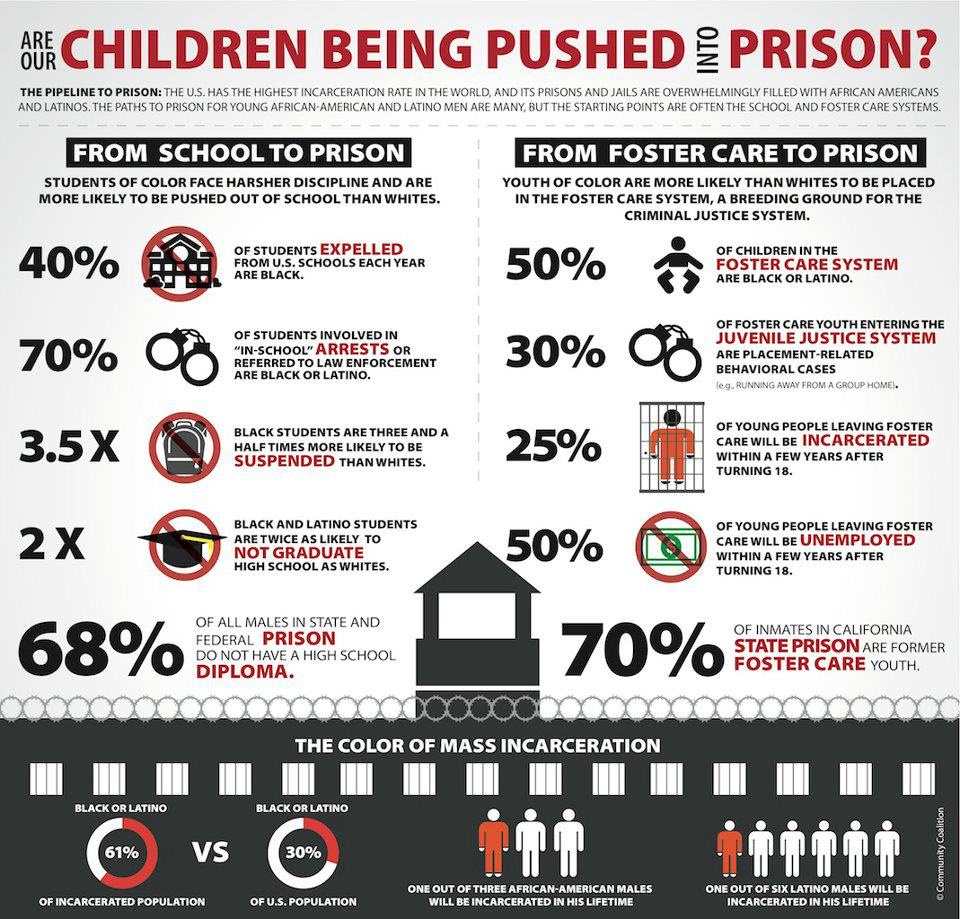
Via PBS
When it comes to building wealth, success is further predetermined by laws. Jamie Utt points to The Land Grant Acts, the Homesteading Act, redlining policies, and the GI bill, as those among a “myriad of other state policies” that “gave away land for little or no cost to White settlers while explicitly or implicitly barring non-White people from acquiring property.”
And property is this country’s main way of building wealth. The impact of these policies on the American families is exceptionally and painfully clear. The average net worth (the value of the stuff you own minus your debt) of white families is $192,500.
In comparison, the average net worth of a Black family is $19,200, about a tenth of that number.
5. The Overwhelming Majority of Women Don’t Lie About Sexual Assault/Rape
One in every five women will be raped in her lifetime and one in every four women in college has been sexually assaulted.
The number is even higher for women of color. According the Justice Department one in every three Native women is raped in this country, the highest rate of any racial group. It’s hard to argue with these numbers, but some still do and many claim survivors are lying.
But that’s statistically almost non-existent. It’s somewhere between 2-3%.
The Enliven Project used data from the Department of Justice’s National Crime Victimization Survey and FBI reports to create the following infographic to illustrate that false rape accusations are exceedingly rare, despite what media reports might suggest.

Via Washington Post
6. Climate Change Is Real And It Affects Communities Of Color The Most
This one is fairly easy. NASA lists 10 different scientific bodies including the American Medical Association and the Geological Society of America that agree climate change is an issue.
The joint statement from 11 various international academies says:
“Climate change is real. There will always be uncertainty in understanding a system as complex as the world’s climate. However there is now strong evidence that significant global warming is occurring.
The evidence comes from direct measurements of rising surface air temperatures and subsurface ocean temperatures and from phenomena such as increases in average global sea levels, retreating glaciers, and changes to many physical and biological systems. It is likely that most of the warming in recent decades can be attributed to human activities.”
Finally, 97% of studies (an overwhelming percentage) agree climate change can be attributed to human causes.
It’s important to mention that communities of color are most impacted by climate change and human-created environmental racism.
Three quarters of hazardous waste landfill sites are in Black and Latinx neighborhoods. Moreover, during natural disasters like the recent hurricane in Haiti, women are often the last to escape, because they tend to prioritize the safety of their family and children.
7. Police Brutality Isn’t About A Few Bad Apples, It’s The Whole Tree
The Guardian has recorded 933 people killed by police this year. Most were Native American, followed by Black Americans then Latinx communities.
Uprisings across the country have protested the effects of anti-Black racism through specific murders of Black men like Philano Castile, Alton Sterling, and Oscar Grant. Together, their deaths illustrate the effects of a pervasive and unrelenting racism.
Following the 1999 death of Amadou Diallo, a Guinean immigrant shot by New York City police after the officers mistook the wallet in his hand for a weapon, psychologist Keith Payne of the University of North Carolina-Chapel Hill developed the weapons identification task of the Implicit Association Test, which gauges implicit bias.
In the test participants are shown images of Black or white people followed quickly by objects which may include tools, keys and guns. They then press one of two buttons, one for tool, one for gun. The idea is to see how often people associate certain objects with certain races.
As you may have guessed, regardless of profession (community member or cop) participants are more inclined to associate Black folks with guns. When you’re a cop with a gun, a license to shoot and impunity to do so the consequences can – and often are – deadly.
***
Spending time with conservative loved ones can be really uncomfortable, which is why so many of us avoid them. We worry that people may be offended, closed-off, or downright hostile towards us and our convictions.
And no one is saying you should politically challenge a relative if it’s dangerous in any way, shape, or form. But if the holidays are a time in which many of us are forced to be together for better or for worse, maybe we can have these difficult talks from the same place of loving that brings us to the dinner table in the first place. Because there is a lot is at stake.
11 million undocumented people live in America, 3 million Muslims, and 8 million LGBTQIA+ folks. Right now, solidarity with them is key and sometimes all it takes something we do everyday: conversation.
And if this last year has taught us anything, maybe it’s time we started talking.
[do_widget id=’text-101′]
Kim Tran is a Contributing Writer for Everyday Feminism. She’s also a collective member of Third Woman Press: Queer and Feminist of Color publishing. Her academic and activist commitments are to laborers, refugee and queer communities. She facilitates workshops on uprooting anti-black racism in Asian American communities. She is finishing her Ph.D in Ethnic Studies at UC Berkeley where writes on race, gender and economics. Her work has been featured on Black Girl Dangerous, Nation of Change and the Feminist Wire. She can be found in any of these capacities at www.kimthientran.com.
Search our 3000+ articles!
Read our articles about:
Our online racial justice training
Used by hundreds of universities, non-profits, and businesses.
Click to learn more







